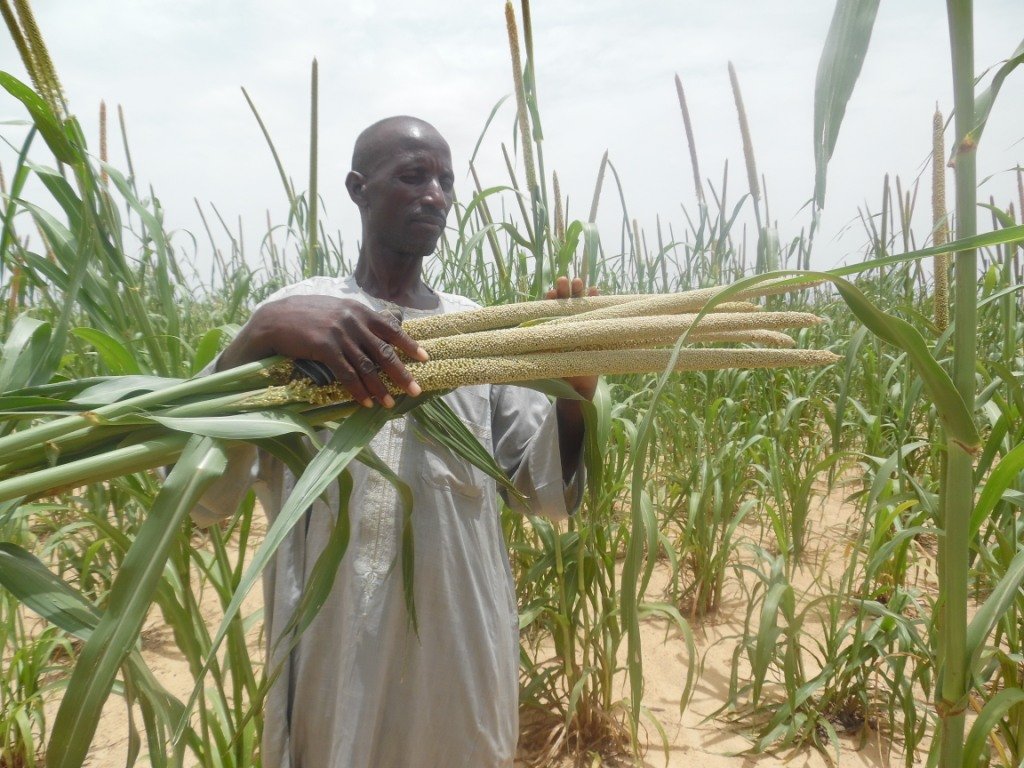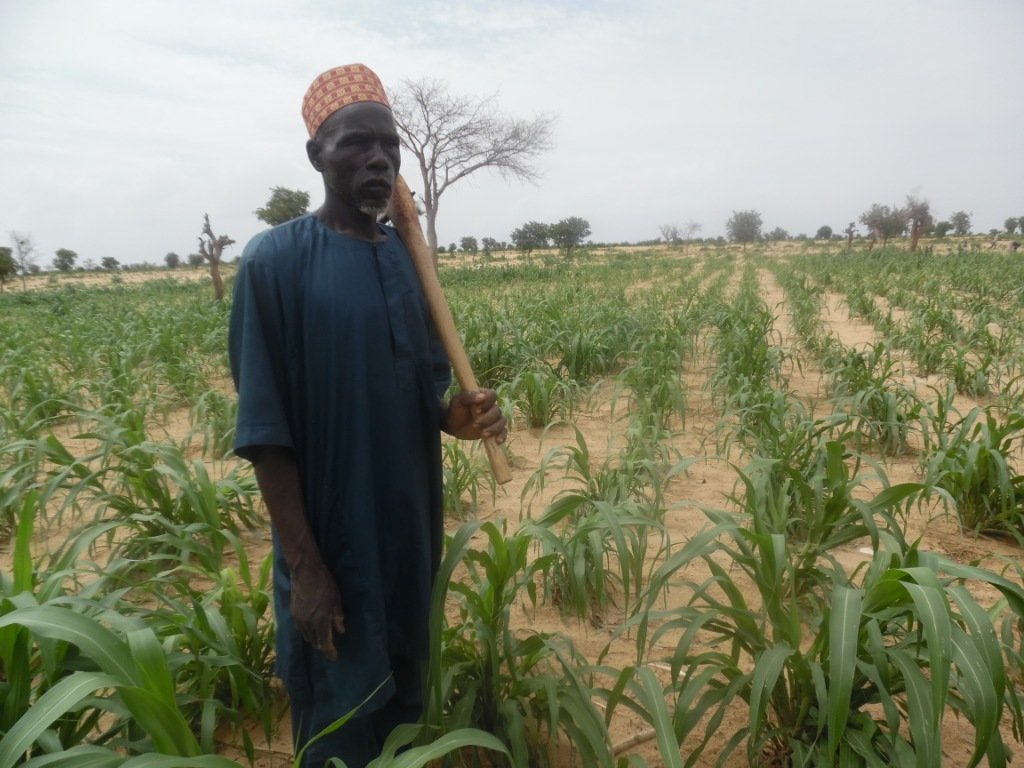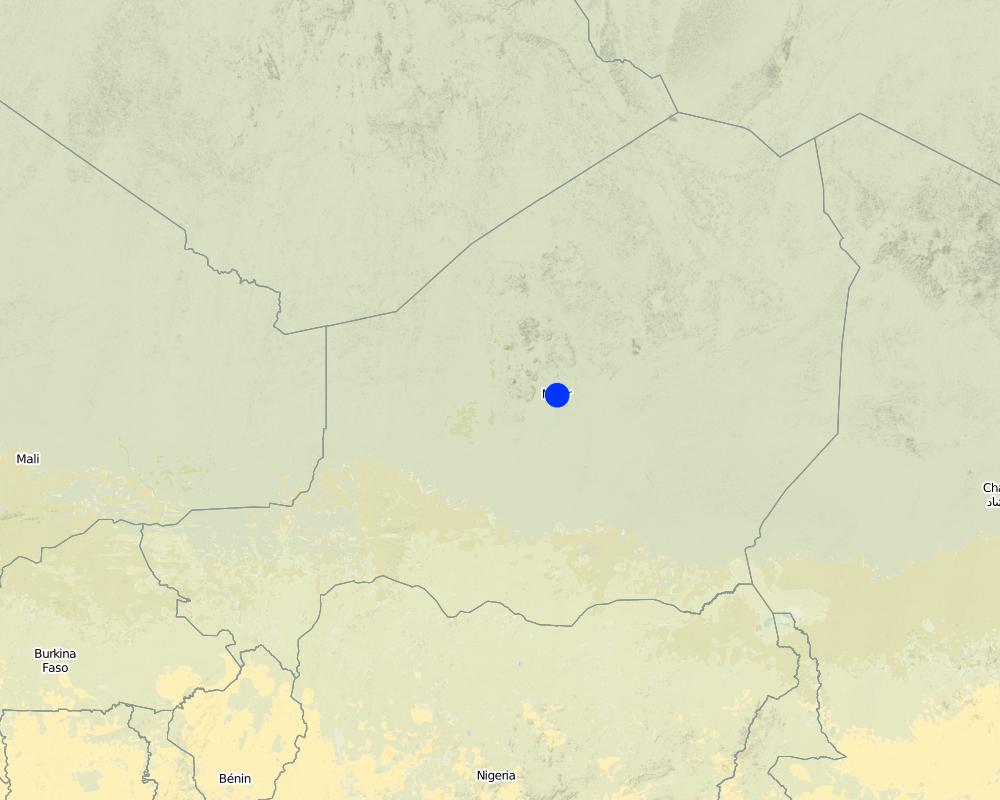Diffusion de la variété améliorée du mil HKP dans le département de Mayahi [Niger]
- Creation:
- Update:
- Compiler: RABO ISSAKA SALISSOU
- Editor: –
- Reviewers: David Beritault, Christine Lottje
Yada irin hatsi mai nagarta HKP cikin jahar Mayahi
technologies_661 - Niger
- Full summary as PDF
- Full summary as PDF for print
- Full summary in the browser
- Full summary (unformatted)
- Diffusion de la variété améliorée du mil HKP dans le département de Mayahi: Aug. 9, 2017 (inactive)
- Improved millet variety HKP: Dec. 6, 2017 (public)
- Improved millet variety HKP: Oct. 31, 2017 (inactive)
- Diffusion de la variété améliorée du mil HKP dans le département de Mayahi: March 14, 2017 (inactive)
- Diffusion de la variété améliorée du mil HKP dans le département de Mayahi: Feb. 20, 2017 (inactive)
View sections
Expand all Collapse all1. General information
1.2 Contact details of resource persons and institutions involved in the assessment and documentation of the Technology
Key resource person(s)
SLM specialist:
Ibrahim Baoua
96970190 / 90423573
baoua.ibrahim@yahoo.fr
Cabinet Sahel Bio
Maradi/Grand marché
Niger
land user:
Souley Anné
96607687
Mayahi/Maitsakoni
Niger
land user:
Sani Sabo
92398978
Mayahi/Maitsakoni
Niger
Name of project which facilitated the documentation/ evaluation of the Technology (if relevant)
Book project: where people and their land are safer - A Compendium of Good Practices in Disaster Risk Reduction (DRR) (where people and their land are safer)Name of the institution(s) which facilitated the documentation/ evaluation of the Technology (if relevant)
HEKS (Hilfswerk der Evangelischen Kirchen Schweiz) (HEKS (Hilfswerk der Evangelischen Kirchen Schweiz)) - Switzerland1.3 Conditions regarding the use of data documented through WOCAT
When were the data compiled (in the field)?
11/10/2016
The compiler and key resource person(s) accept the conditions regarding the use of data documented through WOCAT:
Yes
1.4 Declaration on sustainability of the described Technology
Is the Technology described here problematic with regard to land degradation, so that it cannot be declared a sustainable land management technology?
No
2. Description of the SLM Technology
2.1 Short description of the Technology
Definition of the Technology:
La variété du mil HKP en djerma "Haini Kire Précoce" (mil rouge précoce, en français) est une variété de mil à haut rendement et adaptée au contexte sahélien.
2.2 Detailed description of the Technology
Description:
Le mil (Pennisetum glaucum (L.) R.Br) est cultivé dans plusieurs pays d‘Afrique de l’ouest dont le Niger, le Mali, le Nigeria et le Burkina Faso. Le mil est la céréale la plus cultivée et la plus consommée au Niger et ses tiges sont très appétées par les animaux et servent aussi à la construction des maisons.
La variété du mil HKP a été développé en 1978 par l'Institut National des Recherches Agronomiques du Niger (INRAN), avec pour objectif de mettre au point une variété plus performante et plus adaptée au contexte sahélien. La variété HKP est résistante à la sécheresse, peu sensible à la mineuse de l'épi, légèrement sensible à la photopériode, mais sensible au charbon et au mildiou. Malheureusement cette variété est aujourd'hui toujours au stade de vulgarisation. Ce retard s’explique par des difficultés de gestion technique du système semencier nigérien, le coût élevé des semences améliorées et les difficultés d’accès des producteurs locaux. Cependant, ces dix dernières années on note une avancée significative dans l’adoption des semences améliorées par les agriculteurs qui ont pris conscience que la réalité du changement climatique exige des variétés plus performantes.
La zone agro-écologique de la variété du mil HKP est comprise entre l'isohyète 350 et 800 mm. Elle peut être cultivée seule ou en association avec d'autres cultures telles que le niébé, le sorgho, l'arachide. Son cycle est de 75 à 90 jours. Le mil préfère des sols légers et riches en matière organique. La préparation du lit de semis nécessite un apport de 3 à 5 tonnes de matière organique décomposée à l’hectare et un scarifiage au moyen d’un cultivateur canadien (3 ou 5 dents) à la suite des premières pluies pour enfouir la matière organique. La période optimale de semis est le mois de juin. Dix kilogrammes de semences sont nécessaires pour emblaver un hectare. L'écartement au semi est de 1mx1m entre les poquets et entre les lignes, soit 10.000 poquets à l'hectare. Le semis peut s’associer à la micro dose d’engrais minéral à 6 g/poquet (60 kg/ha) pour le 15-15-15 et 2 g/poquet (20kg/ha) pour le DAP. L'ensemble des travaux d'entretiens doivent être effectués à temps. Il s'agit de deux sarclo-binages, le premier avec démariage à trois plants par poquet au plus tard, deux semaines après le semis; le deuxième sarclo-binage deux ou trois semaines après le premier. Une fumure de couverture en urée est appliquée en deux fois au poquet (pour la zone sud: 50 kg/ha au tallage et 50 kg/ha à la montaison, pour la zone intermédiaire: 25 kg/ha au tallage et 25 kg/ha à la montaison). Un à deux traitements sont prévus en cas d’attaque de mildiou, sinon arracher et brûler ou enfouir dans le sol les plants attaqués par le mildiou et la chenille mineuse. La récolte intervient lorsque les épis sont complètement mûrs et secs. La variété HKP a un rendement potentiel de 1,5 à 2,5 tonnes à l'hectare. Le mil peut être conservé dans un grenier ou après battage dans un sac. Les producteurs apprécient positivement la bonne levée de la culture, sa précocité et son rendement.
2.3 Photos of the Technology
2.5 Country/ region/ locations where the Technology has been applied and which are covered by this assessment
Country:
Niger
Region/ State/ Province:
Maradi
Further specification of location:
Sherkin Haoussa
Map
×2.6 Date of implementation
Indicate year of implementation:
2014
2.7 Introduction of the Technology
Specify how the Technology was introduced:
- through projects/ external interventions
Comments (type of project, etc.):
Le projet Zamtapo pendant ses deux premières années d’intervention a distribué des semences améliorées de mil et de niébé. Les paysans ont bien apprécié la précocité et la production du mil HKP.
3. Classification of the SLM Technology
3.1 Main purpose(s) of the Technology
- improve production
- adapt to climate change/ extremes and its impacts
- create beneficial economic impact
- create beneficial social impact
3.2 Current land use type(s) where the Technology is applied

Cropland
- Annual cropping
Main crops (cash and food crops):
Mil, sorgho, niébé, arachide, sésame, souchet
3.3 Further information about land use
Water supply for the land on which the Technology is applied:
- rainfed
Comments:
La saison de pluie dure 3 à 4 mois de juin à septembre.
Number of growing seasons per year:
- 1
3.4 SLM group to which the Technology belongs
- improved plant varieties/ animal breeds
3.5 Spread of the Technology
Specify the spread of the Technology:
- evenly spread over an area
Comments:
Chaque producteur met en valeur un champ d’une superficie de 0,5ha
3.6 SLM measures comprising the Technology

agronomic measures
- A2: Organic matter/ soil fertility
- A5: Seed management, improved varieties
3.7 Main types of land degradation addressed by the Technology

soil erosion by water
- Wt: loss of topsoil/ surface erosion

chemical soil deterioration
- Cn: fertility decline and reduced organic matter content (not caused by erosion)

biological degradation
- Bp: increase of pests/ diseases, loss of predators
Comments:
Wt : A travers le labour, la vitesse de ruissellement est réduite voir supprimée.
Cn : L’apport de la fumure organique, minérale ou du compost améliore la fertilité du sol.
Bp : Peu sensible à la mineuse de l'épi et au mildiou.
3.8 Prevention, reduction, or restoration of land degradation
Specify the goal of the Technology with regard to land degradation:
- adapt to land degradation
4. Technical specifications, implementation activities, inputs, and costs
4.1 Technical drawing of the Technology
4.2 Technical specifications/ explanations of technical drawing
L'écartement de semi est de 1mx1m entre les poquets et entre les lignes, soit 10.000 plants par poquets
La hauteur de la plante à la maturité varie de 190 à 200 cm.
La longueur de l'épi varie de 50-70 cm.
4.3 General information regarding the calculation of inputs and costs
Specify how costs and inputs were calculated:
- per Technology area
Indicate size and area unit:
1ha
other/ national currency (specify):
F CFA
Indicate exchange rate from USD to local currency (if relevant): 1 USD =:
617.0
Indicate average wage cost of hired labour per day:
1250
4.4 Establishment activities
| Activity | Type of measure | Timing | |
|---|---|---|---|
| 1. | Préparation du sol (y inclus épandage du compost) | Agronomic | Mai |
| 2. | Semi | Agronomic | Juin |
| 3. | Premier sarclage | Agronomic | Juillet |
| 4. | Démariage | Agronomic | Juillet |
| 5. | Deuxième sarclage | Agronomic | Aout |
| 6. | Récolte | Agronomic | Octobre |
| 7. | Transport | Management | Octobre |
| 8. | Stockage | Management | Novembre |
4.5 Costs and inputs needed for establishment
| Specify input | Unit | Quantity | Costs per Unit | Total costs per input | % of costs borne by land users | |
|---|---|---|---|---|---|---|
| Labour | De la préparation du sol au stockage | HJ | 22.5 | 1250.0 | 28125.0 | 100.0 |
| Plant material | Semence | Kg | 10.0 | 300.0 | 3000.0 | |
| Fertilizers and biocides | Fongicide | g | 40.0 | 25.0 | 1000.0 | |
| Fertilizers and biocides | Fumure organique | t | 5.0 | 1600.0 | 8000.0 | 100.0 |
| Fertilizers and biocides | NPK | kg | 60.0 | 300.0 | 18000.0 | 100.0 |
| Fertilizers and biocides | Urée | kg | 50.0 | 300.0 | 15000.0 | 100.0 |
| Total costs for establishment of the Technology | 73125.0 | |||||
If land user bore less than 100% of costs, indicate who covered the remaining costs:
Projet
Comments:
Le cout des équipements ne sont pas évalués parce qu'ils sont inclus dans la main d’œuvre. Dans la pratique agricole de la zone un salarié engagé vient avec son outil de travail.
Les couts pour les engrais chimiques se montent à 45% des couts totaux, une charge considérable et risquée pour des petits producteurs
4.6 Maintenance/ recurrent activities
Comments:
Non adapter à la technologie mil
4.8 Most important factors affecting the costs
Describe the most determinate factors affecting the costs:
Engrais et fongicides.
5. Natural and human environment
5.1 Climate
Annual rainfall
- < 250 mm
- 251-500 mm
- 501-750 mm
- 751-1,000 mm
- 1,001-1,500 mm
- 1,501-2,000 mm
- 2,001-3,000 mm
- 3,001-4,000 mm
- > 4,000 mm
Specifications/ comments on rainfall:
La saison de pluie dure 3 à 4 mois de juin à septembre
Indicate the name of the reference meteorological station considered:
Service départemental de l'agriculutre
Agro-climatic zone
- semi-arid
5.2 Topography
Slopes on average:
- flat (0-2%)
- gentle (3-5%)
- moderate (6-10%)
- rolling (11-15%)
- hilly (16-30%)
- steep (31-60%)
- very steep (>60%)
Landforms:
- plateau/plains
- ridges
- mountain slopes
- hill slopes
- footslopes
- valley floors
Altitudinal zone:
- 0-100 m a.s.l.
- 101-500 m a.s.l.
- 501-1,000 m a.s.l.
- 1,001-1,500 m a.s.l.
- 1,501-2,000 m a.s.l.
- 2,001-2,500 m a.s.l.
- 2,501-3,000 m a.s.l.
- 3,001-4,000 m a.s.l.
- > 4,000 m a.s.l.
Indicate if the Technology is specifically applied in:
- not relevant
5.3 Soils
Soil depth on average:
- very shallow (0-20 cm)
- shallow (21-50 cm)
- moderately deep (51-80 cm)
- deep (81-120 cm)
- very deep (> 120 cm)
Soil texture (topsoil):
- coarse/ light (sandy)
Soil texture (> 20 cm below surface):
- coarse/ light (sandy)
Topsoil organic matter:
- low (<1%)
5.4 Water availability and quality
Ground water table:
5-50 m
Availability of surface water:
poor/ none
Water quality (untreated):
poor drinking water (treatment required)
Is water salinity a problem?
No
Is flooding of the area occurring?
No
5.5 Biodiversity
Species diversity:
- low
Habitat diversity:
- low
5.6 Characteristics of land users applying the Technology
Sedentary or nomadic:
- Sedentary
Market orientation of production system:
- mixed (subsistence/ commercial
Off-farm income:
- less than 10% of all income
Relative level of wealth:
- poor
Individuals or groups:
- individual/ household
Level of mechanization:
- manual work
Gender:
- women
- men
Age of land users:
- youth
- middle-aged
Indicate other relevant characteristics of the land users:
Les producteurs sont majoritairement analphabètes.
5.7 Average area of land owned or leased by land users applying the Technology
- < 0.5 ha
- 0.5-1 ha
- 1-2 ha
- 2-5 ha
- 5-15 ha
- 15-50 ha
- 50-100 ha
- 100-500 ha
- 500-1,000 ha
- 1,000-10,000 ha
- > 10,000 ha
Is this considered small-, medium- or large-scale (referring to local context)?
- medium-scale
5.8 Land ownership, land use rights, and water use rights
Land ownership:
- individual, not titled
Land use rights:
- individual
Water use rights:
- communal (organized)
Comments:
L'accès à la terre se fait soit par héritage, achat ou par gage
5.9 Access to services and infrastructure
health:
- poor
- moderate
- good
education:
- poor
- moderate
- good
technical assistance:
- poor
- moderate
- good
employment (e.g. off-farm):
- poor
- moderate
- good
markets:
- poor
- moderate
- good
energy:
- poor
- moderate
- good
roads and transport:
- poor
- moderate
- good
drinking water and sanitation:
- poor
- moderate
- good
financial services:
- poor
- moderate
- good
6. Impacts and concluding statements
6.1 On-site impacts the Technology has shown
Socio-economic impacts
Production
crop production
Quantity before SLM:
262kg/ha
Quantity after SLM:
679kg/ha
Comments/ specify:
Le rendement du mil est 262kg/ha avant GDT et passe à 679kg/ha après GDT, soit une augmentation de 259%
Socio-cultural impacts
food security/ self-sufficiency
Quantity before SLM:
3 mois de couverture alimentaire
Quantity after SLM:
9 mois de couverture alimentaire
Comments/ specify:
La production obtenue est uniquement destinée à l'auto consommation. Ainsi, avant la GDT la production ne couvre que 3 mois de besoin alimentaire. Tandis qu'avec la GDT elle couvre 9 mois de besoin alimentaire du ménage.
health situation
Quantity before SLM:
Sans fongicide, engrais, produit phytosanitaire
Quantity after SLM:
Utilisation de fongicide, engrais et produit phytosanitaire
Comments/ specify:
Avant la GDT il n'y a aucun risque sanitaire, tandis qu'avec la GDT il y a un éventuel risque sanitaire à long terme lié à l'utilisation de fongicide, engrais et produit phytosanitaire.
SLM/ land degradation knowledge
Quantity before SLM:
limitée
Quantity after SLM:
partage d'expérience
Comments/ specify:
Avant la GDT, les connaissances du producteur sont limitées, tandis qu'avec la GDT le producteur acquiert d'autres expériences.
Ecological impacts
Climate and disaster risk reduction
drought impacts
Comments/ specify:
La variété du mil HKP est résistante à la sécheresse
6.2 Off-site impacts the Technology has shown
Purété variétale
Quantity before SLM:
Variété locale pure
Quantity after SLM:
Variété locale hybride
Comments/ specify:
La variété locale étant pure avant la GDT. Cette pureté variétale se détériore lié à au croisement avec les variétés améliorées. On obtient une variété hybride.
6.4 Cost-benefit analysis
How do the benefits compare with the establishment costs (from land users’ perspective)?
Short-term returns:
very positive
Long-term returns:
very positive
How do the benefits compare with the maintenance/ recurrent costs (from land users' perspective)?
Short-term returns:
very positive
Long-term returns:
very positive
Comments:
La rentabilité est très positive à court ou à long terme surtout en année de bonne production
6.5 Adoption of the Technology
- 10-50%
If available, quantify (no. of households and/ or area covered):
103 ha emblavé du HKP à Maitsakoni pendant la campagne agricole 2016
Of all those who have adopted the Technology, how many have did so spontaneously, i.e. without receiving any material incentives/ payments?
- 10-50%
Comments:
La majorité de ceux qui ont adopté la technologie n'ont reçu aucun soutien. Ils sont attirés par les résultats obtenus dans les parcelles de démonstration
6.6 Adaptation
Has the Technology been modified recently to adapt to changing conditions?
No
6.7 Strengths/ advantages/ opportunities of the Technology
| Strengths/ advantages/ opportunities in the land user’s view |
|---|
|
Haut rendement Résistance à la sécheresse Adaptée au sol de la zone |
| Strengths/ advantages/ opportunities in the compiler’s or other key resource person’s view |
|---|
|
Haut rendement Résistance à la sécheresse Adaptée au sol de la zone |
6.8 Weaknesses/ disadvantages/ risks of the Technology and ways of overcoming them
| Weaknesses/ disadvantages/ risks in the land user’s view | How can they be overcome? |
|---|---|
|
Sensible au charbon et au mildiou |
Arrachage des plants infectés |
| Weaknesses/ disadvantages/ risks in the compiler’s or other key resource person’s view | How can they be overcome? |
|---|---|
|
1) Sensible au charbon et au mildiou 2) Attaque d'insectes floricoles 3) Coût des intrants (engrais et semences) et risque de s'endetter pour les petits producteurs |
1) Arrachage des plants infectés 2) Traitement phytosanitaire 3) Pour améliorer les rendements sans utilisation des engrais chimiques (effets négatifs de l'azote sur le climat), l'emploi ciblé du compost est recommandé. |
7. References and links
7.1 Methods/ sources of information
- field visits, field surveys
20
- interviews with land users
20
- interviews with SLM specialists/ experts
5
- compilation from reports and other existing documentation
7.2 References to available publications
Title, author, year, ISBN:
Rapports d'activités du projet
Title, author, year, ISBN:
Rapports de service d'agriculutre
Title, author, year, ISBN:
Fiches Technniques
Links and modules
Expand all Collapse allLinks
No links
Modules
No modules






